First, the best perspective…
To every thing there is a season, and a time to every purpose under the heaven: A time to be born, and a time to die…
– Ecclesiastes 3:1, 2a
Seventy years ago today, the well-known China Clipper crashed while landing in darkness at the harbor of Port-of-Spain, Trinidad.
The four engine Martin M-130, based in Miami, Florida was one of three luxurious models of this type built for Pan American Airways.

The China Clipper moored in Hawaii – late 1930s
Photo Credit: Hawaii.gov
Click on Photos to Enlarge
Thirty passengers and crew were aboard the Clipper that fateful night, one of whom was Captain Leonard W. Cramer of Syracuse,
New York, a well-known veteran aviator. He was the first officer
and was piloting the plane at the time of the crash, losing his life
along with 22 others. He was also my mother’s uncle.
My mother, Barbara Lindsey, was only six years old when her Uncle Leonard died, but he left a strong and positive impression. She spoke of him with fondness throughout her life, as did other relatives.
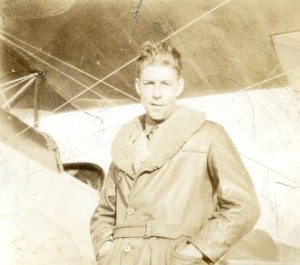
Captain Leonard Cramer October 1929
Photo from collection of Jeff Michaels
As an early aviator, Leonard Cramer was a pioneer, but like many fliers of his day, he also was a risk-taker. The Syracuse, New York Herald Journal described him as “one of the old-time dare-devils of aviation in Syracuse and Central New York”, having survived several close calls during the 1930s.
In June of 1930, Captain Cramer’s seaplane caught fire while afloat more than a mile offshore on Onondaga Lake near Syracuse. He was forced to jump into the water to escape the flames and as he swam toward shore, the fuel tank exploded and the plane sank. He was assisted by a young boy named Bud Windhausen who rowed a boat out to rescue him. He had another close call in October of 1933 when he was providing rides at an air show in Fulton. It was reported that Cramer, “Narrowly escaped death in a 150 foot plunge to the ground… His plane wobbled as it came out of a loop and turned over as it crashed.” On another occasion, in June 1935, he was flying in a circus in Massena and attempted a ‘dead-stick’ landing. “He pulled his plane into the bank of a canal to avoid crashing into a crowd of 2000 people watching the show.” A sudden downdraft was blamed for this accident. He seemingly led a charmed life, walking away unscathed from all three incidents.
In spite of these near disasters, Captain Cramer was highly regarded as a flight officer and pilot, with a long and distinguished record. He was trained at the E B Heath Flight School in Chicago in the late 1920s and became a capable flight instructor. His experience and record of excellence led to a 1940 invitation to provide aerial combat instruction to English fliers. He also ferried bombers between the US and England, earning $1,000 for each Atlantic crossing and on one of these flights – in December 1941 – he set and briefly held the speed record for transatlantic flight. The Herald Journal took note of the event, reporting on a dispatch received from London:
‘The British Ministry of Aircraft Production reports that an American consolidated four engine bomber has set a new record for crossing the Atlantic. The huge plane, called The Liberator by the British negotiated the distance in 8 hours and 18 minutes. The plane was piloted by an American described only as Capt. Cramer.'”
But all of this was in the past. Captain Cramer sat in the left seat of the M-130 China Clipper, piloting the well-engineered and beautiful flying boat that had enjoyed nearly a decade of storied history of its own. In October of 1935 it was delivered to Pan American Airways
in San Francisco and spent the balance of the 1930s island hopping across the Pacific, regularly landing at Pearl Harbor, Midway Island, Wake Island, Guam, and Manila as it delivered passengers and mail along the route and to the ultimate destination of Shanghai, China. There had been many passages across the Pacific made with a great safety record, but now the famous plane was based in Miami.
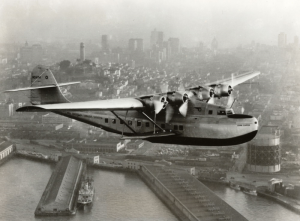
The China Clipper in flight over San Francisco during the late 1930s
Photo Credit: http://postalmuseumblog.si.edu/
Captain Cramer’s day began with a 6:30 AM departure from Miami, followed by a stop in San Juan, Puerto Rico at 2:39 PM for refueling. Now more than five hours out from San Juan, the Clipper was due shortly at Port-of-Spain. From there, the final destination would be Leopoldville, Belgian Congo (today Kinshasa, Democratic Republic
of the Congo) in Central Africa. Those on the plane included flight crew members, additional Pan American Airways employees, a few businessmen, spouses, and a young family on their way to Liberia
to serve as missionaries with the Africa Inland Mission.
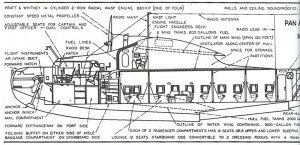
Cutaway drawing of China Clipper interior
Photo credit: Wings to the Orient: Pan American Clipper Planes
1935 to 1945 – A Pictorial History
Shortly before 9:15 PM on the evening of January 8, 1945, Captain Cramer began his descent to the harbor at Port-of-Spain. The harbor lights were easily seen beneath the darkened sky and in a matter of seconds, the belly of the flying boat would gently touch down on the quiet water, followed by a smooth taxi to the mooring dock. However, something wasn’t right in the initial approach, so Captain Cramer regained altitude, made a wide circle and began a second descent.
The official report of the Civil Aeronautics Board (forerunner of the NTSB) stated that as Captain Cramer made his second landing attempt, “The plane first contacted the water at more than normal landing speed and in a nose-low attitude.” When the plane struck the water, the result was catastrophic failure of the hull, causing the plane to rupture, breaking in two. The China Clipper sank immediately, causing the deaths of 23 of the 30 people on board, including Captain Cramer. The final report of the CAB was released on April 24, 1946 and assigned most of the blame for the crash to Captain Cramer, particularly for misjudging his altitude on the approach.
However, other sources indicate the possibility of contributing factors that led to the crash. There were several reports of the presence of a submerged log that had been placed in the water as a hazardous obstacle meant to cause harm. Others thought there was a small unseen boat that was struck by the Clipper as it touched down. Yet another source mentioned an explosive mine. In addition, the crash occurred during the final months of World War II, giving rise to rumors, which were compounded by customary government secrecy during war time. Whatever the cause, the loss of the China Clipper and 23 men, women, and children was tragic and horrific.
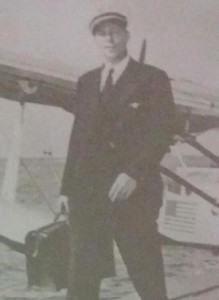
Captain Cramer disembarks – early 1940s
newspaper photograph – source unknown
The shock of Leonard Cramer’s sudden death was devastating to my family. I recall my grandfather Edward Lindsey, who was Leonard’s brother-in-law, speaking of him on occasion. As he would share a story or even just mention Leonard’s name, he seemed to look off into the distance as if he were back in time…
Death, especially when tragic and unexpected, has a deep and lingering effect on those left behind, often creating a void that can never be filled. This is a part of the human experience and one that touches each of us at some point in life. However, the memory of Leonard Cramer continues to be honored in my family despite the tragic circumstances that led to his untimely death.
Captain Leonard Wright Cramer was survived by his wife Marjorie Cramer, his two sons – Leonard W. Cramer, Jr. and Franklin I. Cramer, parents Franklin and Blanche Cramer, his sister Rosamond (Edward) Lindsey, brother Kenneth (Alice) Cramer, and several nieces and nephews including Beverly and Barbara Lindsey. He was 39 years old at the time of his death and was buried in Mount Adnah Cemetery, Fulton, New York.
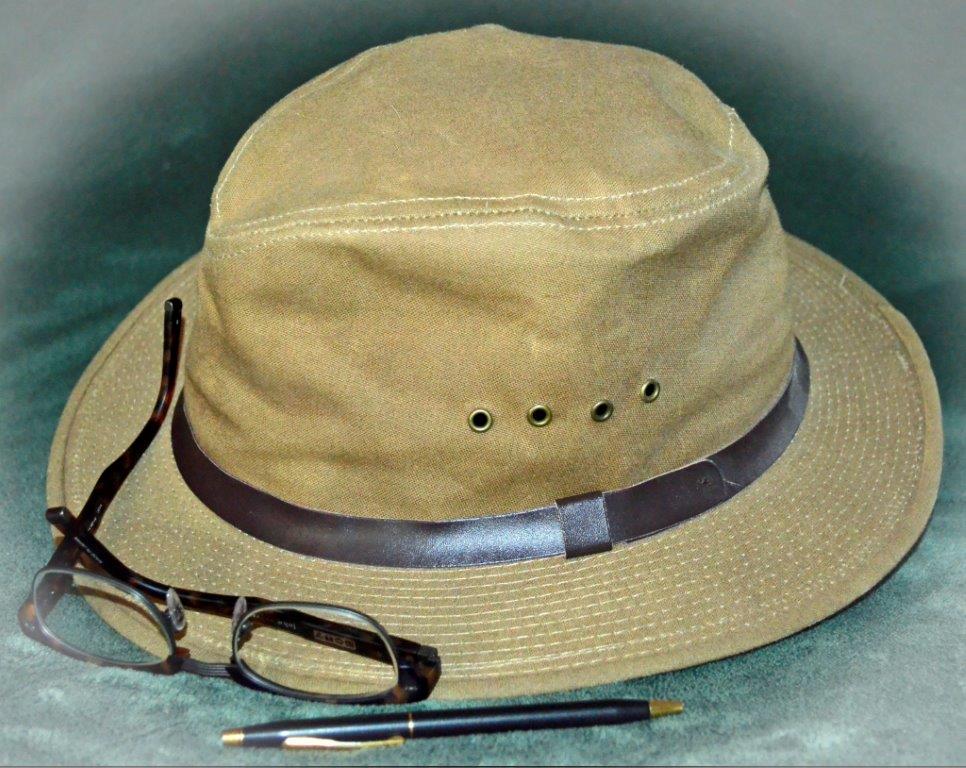
© Jeffery J. Michaels / Plain English Publications 2015
(quotations are allowed with attribution to this blog)
Sources:
Personal recollections of Capt. Cramer’s son, Frank Cramer
New York Sun June 27, 1930
Syracuse American October 15, 1933
Syracuse Journal June 17, 1935
Brooklyn Eagle January 9, 1945
Syracuse Herald Journal January 9 and 10, 1945
Official report of the Civil Aeronautics Board April 24, 1946
Cemetery records for Mount Adnah Cemetery, Fulton, New York

My father had a ticket for this flight but missed it. From the information available at the time, he said that when the Clipper took off from its last port of call it struck an object in the water that pierced the hull. Upon landing in Trinidad (at excessive speed) the previously punctured hull tore wide open under the force of the water causing the hull failure. No doubt the threat of obstructions in the water was played down for commercial reasons. If anyone knows where to find records of this flight, especially booked passengers, I would appreciate your passing it along. I’m also searching for records of Pan American-Grace Airlines (Panagra) for the ’60’s.
With all due respect and the sympathy due to relatives and descendants of L. W. Cramer, First Officer – without forgetting the respect owed to those who perished and for whose sake history ought to pursue the truth to the best of ought ability,
The official report stated,
“During the first approach he [First Officer Cramer] came in too high so he was forced to circle the landing area. During the second try, the Martin descended too low and contacted the water at more than normal landing speed…”.
The report went on to state the probable chase of the accident as,
“(1) First Officer failure to realize his proximity to the water and to correct his attitude for a normal landing and, (2) the lack of adequate supervision by the Captain during the landing, resulting in the inadvertent flight into the water in excess of normal landing speed and in a nose-down attitude.”
In the end, the report mentions two failed approaches and makes no references to any logs floating in the water.
Respectfully. H. Lares.
Dear Henry, I fully and accurately quoted the official report of the Civil Aeronautics Board in my article, but I also reported the unofficial questions discovered in my research. There is nothing that should be considered misleading in my recounting of that tragic event. Thank you for writing! Best, Jeff
Jeff
I just finished watching “Across the Pacific” which eventually ended up with discussion about how key the China Clipper was to Pan Am And the airline industry. I ended up wondering what the status was of the China Clipper before they mentioned it had crashed, which in turn had me do some searching on the web.
Question: do you know if the wreckage was ever recovered? I can’t find any mention of it so I was wondering if it is still under water there and or if it’s location is mapped.
You may find it interesting that I live in La Vergne and I am an Aircraft Mechanic at the Shelbyville Airport (I am also a pilot), which makes this whole story and your blog and the subsequent responses very interesting.
I hope you may know about the recovery.
Sincerely,
Ken Rutschow
Hi Ken:
First, thanks for writing – we’re practically neighbors. I always appreciate those who find interest in this important historical event. I am unaware of where the China Clipper was disposed of, but the remains were no doubt studied to understand the crash. I received a note from a man some years ago and he claimed to know where the plane is buried. He also said he planned to participate in an expedition to recover the plane’s remains. I have not researched that part of the story, but I think it’s more likely that the plane was buried at sea – just a guess on my part.
Best, Jeff
Hello,
One of the stewards, Jayme de Azevedo, sometes reported as Jaime Azevedo, and days following the accident appears in newspapers as Jaime Axavedo, was my grandfather. As with some of the previous commentators, I know so very little about this man. Jayme’s wife, my grandmother, was travelling to Miami, after the crash, when she was struck by a large vehicle and lived for many years after, but in a vegetative state. My mother has very little information, as she was just 4 months old when the crash occurred. Every piece of information, tragic, or hopeful is a gift I would like to give her as she also fails in health. Long gone are the desires for blame, or “what if” , and what remains is a desire to gift someone who has had only ghostly parents, and replace those ghosts with pieces of information.
Is anything known of this young man? Born in 1909, became a US citizen in 1936. I have much of his immigration paperwork, and transition from Brazil, where he is listed as a steward for Pan Am, but very little else. I wonder if he was serious, or funny, kind and diligent. What was the life of a steward like on this luxury ship on her final flight? What were those moments like after San Juan, and before the cold water hit his skin? The newspapers in the area say it was going to be unexpectedly cold, there was snow predicted even in the deep south, with record lows in Georgia. So maybe it was a chilly night. I just wonder if anyone can fill in some moments to take us back there for a moment. Not the glitz of its flight across the Pacific, that’s well documented and he wasn’t aboard until probably 1943. And then he never really left.
Thank you,
Steven
Hello Steven:
Thank you for writing. So much tragedy through this plane crash and I’m sorry your family has suffered so much over the years. I checked the 1940 Federal Census for Miami, Florida and I found Jayme Azevedo (age 31), with the occupation of airline steward. Also listed at the same address was Sylvia Lazzarim (age 34), also an airline steward. They rented and lived at 2401 S W 28th St. in Miami. Both gave their place of birth as South America. One other important piece of information is that they both stated they were residents of New York City on April 1, 1935!
Best wishes, Jeff Michaels
Fascinating article. I’m reading a book called Age of Heroes by Henri Keyzer-Andre. He says the plane hit a British boat on landing and visibility was poor as the pilot did not drop any landing flares…apparently his three soon to be adopted children were on board. The book is somewhat fishy and I don’t believe much of it so wondered if you had a flight manifesto from that day?
Hi –
Thanks for writing, especially today, the 74th anniversary of the famous crash. Concerning the writing of Mr. Keyzer-Andre, I dispute his claims. There were several theories put forth concerning the cause of the crash, so I have no real problem with the possibility of a boat possibly contributing to the mishap. However, he is the first writer who mentioned anything about flares. As for the “three soon to be adopted children” – this is simply not true. Captain Cramer had two sons of his own and there was never any indication of a pending adoption from members of my family. I was acquainted with his wife as a child and my mother enjoyed regular visits with her. In addition, I spoke with Captain Cramer’s son prior to writing this article and if this was part of the story, I am quite confident that he would have told me. Again, this is very simply not true. Therefore, I believe his research – if any was done – is suspect at best. As for a flight manifest, the newspaper articles I cited included those details and I have referenced them for anyone who wishes to verify my research. I’m not sure where the author you refer to got his information, but there is no substitute for the hard and diligent work of research in original sources. Thanks again for writing!
Jeff Michaels
Thanks so much for replying Jeff. Fantastic research and knowledge. The more I read the book of Keyzer-Andre’s the more suspicious I grow. From a timeline perspective, things do not stack up and he mentions a number of crashes which simply can not be found. Would be happy to share the excerpt from the book surrounding the China Clipper if you’d be interested?
Thanks
Hi, Jeff. Our father, James D Gibson, was the station manager for Pan American in Trinidad at the time of the crash. He is now deceased, but left his own account of the events. If you’re interested, let me know where I can send you a copy.
Hi Martha:
Thank you for your note yesterday! I am always interested in further conversation about this crash – sad for so many, but also fascinating as a historic event. You can reach me at my e-mail address: ThePlainEnglish@gmail.com.
I would welcome any information you have – and of course I will be happy to provide anything else I have to you or others who are interested. I have heard from many family members of those who were involved in the crash and they always have interesting insights to share.
Thanks again…
Jeff Michaels
My Grandfather was a steward on board the flight. I would be very interested in the account. I have little else to share in return. I have a few photos, and newspaper clippings, but nothing unique. He was a young man, born in 09, and my mother was just 4 months old, so she heard very little except for the exciting early China Clipper days. He was only involved in the Miami runs.
Thanks for the excellent article.
I have some more details of Leonard’s early wartime career in Britain – see
http://www.afleetingpeace.org/the-ata/index.php/9-lists/2-ata-men-1940#FirstAmericans
(and scroll down)
He was among the very first group of American pilots to volunteer for the Air Transport Auxiliary, which was a civilian organisation for ferrying new and repaired aircraft to operational airfields; in fact, he appears to have been the first one to be accepted. At the time the Battle of Britain meant that the UK was in desperate need of good pilots.
He was then seconded to the RAF Atlantic Ferry Organisation after a few months (and a couple of accidents).
And his ATA personnel file definitely lists his father as “Frank I Cramer, of Baldwinsville, NY”, by the way.
Hope this helps,
Terry
I seriously love your blog.. Very nice colors
& theme. Did you make this site yourself? Please reply back as I’m hoping to create my own site and would like to learn where you got this from or just what the theme is named.
Thank you!
My great-uncle, Carl “Kid” Rogers died in the China Clipper accident at Port of Spain, Trinidad, in 1945. I was not yet born and know so little about him. I do know that he was passionate about flying and dreamed of becoming a pilot when he was young. I have a scrapbook he put together about avation, a couple of Pan Am items and a copy of the letter sent to my aunt, Ruby Sibole Rogers, notifying her of the accident and the failed attempts to find his body. Any additional information would be welcome.
Thank you,
Cece Boyer Myers
Cece, my grandfather was lost aboard the flight, and I too have very little knowledge of him, less than you do of Kid Rogers in fact. I have some newspaper clippings that talk about, rather list, who was aboard. That’s about all. I want very much to try and find the announcement that my Grandmother would have received, I’m hoping she would have at least. We have nothing left of her, as she wasn’t able to speak of him. I’m wondering what the letter said, how she would have read that news. Was it matter of fact, or were there humans writing the letter. A time of war, would that mean a time when these letters were just typed in batches. It would mean so much, and anything I could answer in return I would love to.
Hello can you provide a passenger manifest for this flight?
Hi Jeff
I have been diligently researching the Cramers and came across your article on Leonard W Cramer. I believe Leonard is descended from Stephen (1850-1881 to 1884) and Martha McKay Cramer (1850-1895) last from Huron County, MI and previously from Ontario, Canada. Stephen Cramer was the brother of my great grandmother Emma Cramer Lancaster. If I am correct there is a genealogy back to the German Palatine immigrants who arrived in NY in 1710.
Stephen Cramer’s father, Isaiah Robin Cramer, was born in Elmira NY, lived in Ontario with his wife Catherine Young Cramer and produced 10 children including Stephen and my Emma. Eventually most, but not all, of these Cramers moved to Michigan which happens to be where I am from. Stephen’s 3 sons appear to have moved to NY after the deaths of their parents. The question I’m trying to resolve is why to NY and not to Northern MI where the majority of the Cramers settled? Who, what was the NY connection?
If interested in kicking any of this around you can reach me at the included email. Loved your your story on Leonard!
Larry Brown